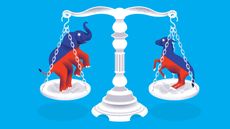About Kiplinger’s Economic Outlooks
Regularly updated insights on the economy’s next moves.
- (opens in new tab)
- (opens in new tab)
- (opens in new tab)
- Newsletter sign up Newsletter


Kiplinger's Economic Outlooks are written by the staff of our weekly Kiplinger Letter and are unavailable elsewhere. Click here for a free issue of The Kiplinger Letter or for more information.
If you already subscribe to the print edition of the Letter, click here to add e-mail delivery (opens in new tab) and the digital edition at no extra cost.
Gross Domestic Product Outlook
Read our current GDP forecast »
Gross domestic product is the broadest indicator of the economy, measuring the value of final goods and services produced in the U.S. in a given time period. It is perhaps the most closely watched indicator as well, serving as a guidepost for Federal Reserve interest rate policy and for budgeting in both government and private industry.

Sign up for Kiplinger’s Free E-Newsletters
Profit and prosper with the best of expert advice on investing, taxes, retirement, personal finance and more - straight to your e-mail.
Profit and prosper with the best of expert advice - straight to your e-mail.
At Kiplinger, we examine what trends are driving GDP up (or down) and forecast its future direction quarter by quarter.
Interest Rates
Read our current interest rates forecast »
Interest rates are of tremendous interest to borrowers (for whom they are a cost) and lenders (a category that includes individuals trying to get some return on their bank savings). Almost everyone is in one or both categories. The level of short-term rates, such as those used by banks when loaning each other money overnight, is set by the Federal Reserve through its Open Market Committee, usually at regularly scheduled Fed meetings.
Market interest rates, including those in money markets and offered on consumer products such as certificates of deposit (CDs), follow the Fed's lead but are also subject to other influences — for example, risk, transaction costs and expectations of inflation. Generally, the longer the period of the loan, such as with 10-year Treasury Bonds or mortgages, the more important market factors become compared with the Federal Reserve's actions. We forecast both what we expect the Federal Reserve to do in the near term and to what extent that will affect the direction of long-term interest rates.
Inflation Rate
Read our current inflation forecast »
Inflation is the generally rising price of goods and services, or why things cost more. It's measured by the Department of Labor using a sample, dubbed a "market basket," of what people in urban areas in the U.S. actually buy each month. Then each month, data collectors check the prices of those items. From that research, we get the Consumer Price Index (CPI). A component of that index, the core inflation rate, which excludes the more volatile prices of food and energy, is also closely watched. At Kiplinger, we forecast changes in both.
Economists generally believe that moderate inflation of about 2% is best for an economy. Prices that are rising too quickly cause consumers heartburn, of course, but prices that are flat or falling are a problem, too. This condition, known as deflation, makes debts more expensive to pay back and can lead to declining business investment.
Employment Outlook
Read our current jobs forecast »
If gross domestic product is the broadest indicator of the economy, employment is the one most personally felt. These are people's jobs we're talking about.
Two distinct metrics make up the employment forecast. The more important one is the "payroll report," a summation by the Department of Labor of how many jobs the economy has created (or lost) each month. This data is broken out by sector, such as manufacturing, mining and health care. Note that simply to keep up with population growth, the economy needs to add more than 100,000 jobs every month; otherwise the unemployment rate will rise.
That rate is the other closely watched figure. It's a simple division of the number of people who have looked for work in the prior four weeks but who do not have a job by how many people are currently in the labor force. That simplicity belies some underlying concerns about the unemployment rate. One key concern: Potential workers who aren't actively looking for work aren't included in the calculation.
Energy
Read our current energy forecast »
Like it or not, petroleum and natural gas remain incredibly important to the U.S. economy. Knowing where oil prices are headed is critical to businesses of all stripes, from airlines to plumbing companies. Consumers planning their family budgets and their vacations care, too. Not only do we monitor Department of Energy reports, but we also talk to commodities traders and petroleum engineers to forecast price trends, changes in production technologies and consumer habits.
Housing
Read our current housing forecast »
In addition to being the roof over our heads, housing is an important sector in the economy. Three statistics form the core of our coverage: sales of existing homes (and the prices those sales fetch); sales of new homes; and housing starts, which reflect new construction that is counted in GDP.
Because housing is a diversified and highly regional industry, our reporting and forecasting are informed by other research as well as conversations with industry experts as well.
Retail
Read our current retail forecast »
Consumers are the engine of our economy, and when their spending flags, business feels it. We examine trends that are influencing their habits, such as falling gas prices, to forecast what they'll be buying in the future and how much they'll be willing to shell out both on everyday items and on big-ticket purchases such as cars and trucks.
Trade
Read our current trade forecast »
All nations of consequence trade with others. Those that buy more from other countries than they sell in turn have a trade deficit, and that's been the story for the United States since the mid-1970s.
How big that deficit will be, and whether the changes will result from more (or fewer) imports or more (or fewer) exports, is the crux of our forecasting. We look at specific sectors (such as agriculture) where the United States is doing well selling abroad, as well as what items (such as smartphones) we buy from overseas. We also discuss the strength of the dollar versus foreign currencies and how that affects trade trends.
Business Equipment Spending
Read our current business spending forecast »
How much businesses are laying out in investment is critical to other businesses in guiding their own spending. In making our forecasts for the direction of business spending in the quarters and years ahead, we follow two indexes from the Census Bureau: Durable Goods Shipments and Orders and Business Inventories reports.

Jim joined Kiplinger in December 2010, covering energy and commodities markets, autos, environment and sports business for The Kiplinger Letter. He is now the managing editor of The Kiplinger Letter and The Kiplinger Tax Letter. He also frequently appears on radio and podcasts to discuss the outlook for gasoline prices and new car technologies. Prior to joining Kiplinger, he covered federal grant funding and congressional appropriations for Thompson Publishing Group, writing for a range of print and online publications. He holds a BA in history from the University of Rochester.
-
-
 Longevity: The Retirement Problem No One Is Discussing
Longevity: The Retirement Problem No One Is DiscussingMany people saving for retirement fail to take into account how living longer will affect how much they’ll need once they stop working. What should they do?
By Brian Skrobonja, Chartered Financial Consultant (ChFC®) • Published
-
 Capital Gains Taxes Trap: How to Avoid Mutual Fund Tax Bombs
Capital Gains Taxes Trap: How to Avoid Mutual Fund Tax BombsIt’s bad enough when your mutual fund’s assets lose value, but owing unexpected capital gains taxes after those losses is doubly frustrating.
By Samuel V. Gaeta, CFP® • Published
-
 Kiplinger's Retail Outlook: Consumers Are Still Resilient
Kiplinger's Retail Outlook: Consumers Are Still ResilientEconomic Forecasts Kiplinger's Retail Outlook: Sales this year are likely to be mostly stable, even as the economy slows.
By David Payne • Last updated
-
 Kiplinger Energy Outlook: Surprise OPEC Move Sends Oil Prices Soaring
Kiplinger Energy Outlook: Surprise OPEC Move Sends Oil Prices SoaringEconomic Forecasts Kiplinger Energy Outlook: Surprise OPEC Move Sends Oil Prices Soaring
By Jim Patterson • Last updated
-
 Kiplinger’s Interest Rates Outlook: Rates Likely to Rise Again After Banking Crisis is Over
Kiplinger’s Interest Rates Outlook: Rates Likely to Rise Again After Banking Crisis is OverEconomic Forecasts Kiplinger’s Interest Rates Outlook: Rates Likely to Rise Again After Banking Crisis is Over
By David Payne • Last updated
-
 Kiplinger's GDP Outlook: The Economy is Slowing, But Not Quickly
Kiplinger's GDP Outlook: The Economy is Slowing, But Not QuicklyEconomic Forecasts The economy is slowing, but not quickly. There may be a recession in the second half of 2023, but it could be delayed.
By David Payne • Last updated
-
 Where the Midterm Election Races Stand Today
Where the Midterm Election Races Stand TodayEconomic Forecasts In a tight race, these state elections may make the difference when midterm results are announced in November.
By Sean Lengell • Published
-
 PODCAST: Is a Recession Coming?
PODCAST: Is a Recession Coming?Smart Buying With a lot of recession talk out there, we might just talk ourselves into one. We take that risk with Jim Patterson of The Kiplinger Letter. Also, dollar stores: deal or no deal?
By David Muhlbaum • Published
-
 Semiconductor Stocks: A Smart Bet for the Long Haul
Semiconductor Stocks: A Smart Bet for the Long HaulBecoming an Investor Stocks in this growing industry will stay in demand long after supply-chain snarls are unraveled.
By Andrew Tanzer • Published
-
 A Dynamic Duo for Yield in 2022
A Dynamic Duo for Yield in 2022Investing for Income Investors should maintain core positions in both REITs and utilities, with regular contributions to both.
By Jeffrey R. Kosnett • Published









